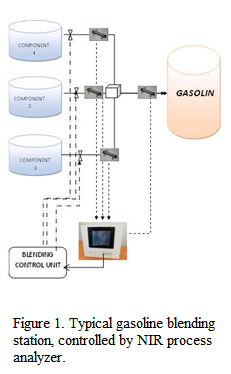RL Blogs

By Modcon-Systems Ltd.
May 25, 2014Blend process optimization can prevent giveaway and save companies significant value. |
||
| Contributed by: Gregory Shahnovsky, Tal Cohen, Ronny McMurray
Blending operations are major refinery activities, in production of crude oil for crude distillation feedstock, in diesel blending and in production of gasoline.
Generally speaking, blending is performed either batch-wise, or in a continuous mode. In batch productions, predetermined volumes of each component are introduced into a mixing tank. After mixing, samples are withdrawn for laboratory analyses, and one must wait for the test results to decide whether to approve or to repair the batch.
This procedure is very time consuming and uneconomic, as lab tests and reprocessing are time-consuming events, which retard dispatching of the tank-load. On-line blending is a preferred technology. Simultaneously all components are directed into a static mixer device. The ratio between the flow velocities of the different component streams is of great importance, as these determine the physical properties of the blend.
In contrast to batch blending, continuous blending enables on-line to adjust the physical properties by changing ratio between the components. Once the required properties are achieved there is no need any more to repair a produced blend, as it was in spec throughout its entire production time.
Laboratory analyses are too slow in efficient blending process control, where its main target is to reach requested properties in the shortest possible time. It is a common practice to save time, that for process control laboratories only partially perform the analyses.
To reduce the interval of uncertainty between sequential laboratory analyses, the task of on-line process analyzers is to quantify a broad range of physical properties throughout the entire production process. It enables the correction of the component ratio at the earliest stage of production, based on real time quantitation of physical properties, and without any time lag.
Following the chemico-physical fundamentals, they are based on two main types of process analyzers that exist. The first type of analyzers are conventional discrete analyzers based on official ASTM or other standardized methods.
A major drawback of these analyzers is their dedication to measure one single physical property, and using one specified method only. Minimum but effective process control still requires implementing different types of analyzers to guarantee correct ratio between different blending components.
A variety of different analyzers is expensive in purchase and maintenance, especially when they are in general mechanical analyzers with many wearing parts, like for example the ROM and MON analyzers. To provide an efficient tool to the operators, all measurements and analytical data from the analyzers must be localized and users friendly be displaced in a control room to give an entire overview of the process running.
The major task in crude blending is to reduce the cost of crude blends by mixing high quality crudes with low quality crudes. However, physical properties must conform the requirements for maximized CDU utilization to produced highly demanded distillates.
Gasoline is a mixture of an entire range of different refinery products that must fully comply with the local legislative standards. Especially, octane enhancing substances are important, but they are relatively very expensive.
Prevention of unnecessary giveaways, dictate refineries and gasoline blenders to maintain the octane numbers closest to its lower limit. Further to that, also seasonal climate differences dictate to change blending recipes of gasoline and diesel to comply with varying seasonal specifications, such as in pour points, RVP etc.
Due its transparency, NIR process analyzers perfectly fit for gasoline blending. Aside from these, NMR process analyzers are also applicable in opaque process streams such as in crude oil blending
Correlative analyzers are multi property a multi stream process analyzers. The use of one single instrument to measure physical properties of feed and blend streams alike provides an excellent tool in blending optimization. Real time on-line analytical data enables to fine tune the ratio between the different feed streams, as such that the blend is of lowest possible cost but complies its specification.
About Modcon Systems:
Modcon Systems specializes in performing process control automation, instrumentation and analyzer projects with turn-key delivery, support and training. Modcon-Systems Ltd. product line includes On-line Process Analyzers and Systems, Process Control & Automation, SCADA and Industrial Network Solutions, Environmental Control, Gas Detectors and Air Pollution Analyzers. Modcon-Systems Ltd. specialty analyzers include the Beacon 3000 NIR Process Analyzer and the MOD 8000 NMR Process Analyzer. | ||
|
|










